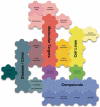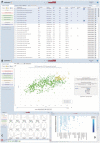canSAR: an integrated cancer public translational research and drug discovery resource
- PMID: 22013161
- PMCID: PMC3245005
- DOI: 10.1093/nar/gkr881
canSAR: an integrated cancer public translational research and drug discovery resource
Abstract
canSAR is a fully integrated cancer research and drug discovery resource developed to utilize the growing publicly available biological annotation, chemical screening, RNA interference screening, expression, amplification and 3D structural data. Scientists can, in a single place, rapidly identify biological annotation of a target, its structural characterization, expression levels and protein interaction data, as well as suitable cell lines for experiments, potential tool compounds and similarity to known drug targets. canSAR has, from the outset, been completely use-case driven which has dramatically influenced the design of the back-end and the functionality provided through the interfaces. The Web interface at http://cansar.icr.ac.uk provides flexible, multipoint entry into canSAR. This allows easy access to the multidisciplinary data within, including target and compound synopses, bioactivity views and expert tools for chemogenomic, expression and protein interaction network data.
Figures






Similar articles
-
canSAR: updated cancer research and drug discovery knowledgebase.Nucleic Acids Res. 2014 Jan;42(Database issue):D1040-7. doi: 10.1093/nar/gkt1182. Epub 2013 Dec 3. Nucleic Acids Res. 2014. PMID: 24304894 Free PMC article.
-
canSAR: update to the cancer translational research and drug discovery knowledgebase.Nucleic Acids Res. 2021 Jan 8;49(D1):D1074-D1082. doi: 10.1093/nar/gkaa1059. Nucleic Acids Res. 2021. PMID: 33219674 Free PMC article.
-
canSAR: an updated cancer research and drug discovery knowledgebase.Nucleic Acids Res. 2016 Jan 4;44(D1):D938-43. doi: 10.1093/nar/gkv1030. Epub 2015 Dec 15. Nucleic Acids Res. 2016. PMID: 26673713 Free PMC article.
-
Chemical biology approaches to target validation in cancer.Curr Opin Pharmacol. 2014 Aug;17:87-100. doi: 10.1016/j.coph.2014.07.007. Epub 2014 Aug 28. Curr Opin Pharmacol. 2014. PMID: 25175311 Review.
-
Chemical modulators working at pharmacological interface of target proteins.Bioorg Med Chem. 2012 Mar 15;20(6):1893-901. doi: 10.1016/j.bmc.2011.12.016. Epub 2011 Dec 14. Bioorg Med Chem. 2012. PMID: 22227462 Review.
Cited by
-
Targeting tumor suppressor genes for cancer therapy.Bioessays. 2015 Dec;37(12):1277-86. doi: 10.1002/bies.201500093. Epub 2015 Oct 7. Bioessays. 2015. PMID: 26445307 Free PMC article. Review.
-
Sis2 regulates yeast replicative lifespan in a dose-dependent manner.Nat Commun. 2023 Nov 27;14(1):7719. doi: 10.1038/s41467-023-43233-y. Nat Commun. 2023. PMID: 38012152 Free PMC article.
-
Comprehensive Computational Analysis of Honokiol Targets for Cell Cycle Inhibition and Immunotherapy in Metastatic Breast Cancer Stem Cells.Evid Based Complement Alternat Med. 2022 Jul 8;2022:4172531. doi: 10.1155/2022/4172531. eCollection 2022. Evid Based Complement Alternat Med. 2022. PMID: 35845599 Free PMC article.
-
Identification of the DEAD box RNA helicase DDX3 as a therapeutic target in colorectal cancer.Oncotarget. 2015 Sep 29;6(29):28312-26. doi: 10.18632/oncotarget.4873. Oncotarget. 2015. PMID: 26311743 Free PMC article.
-
KIAA0101 as a new diagnostic and prognostic marker, and its correlation with gene regulatory networks and immune infiltrates in lung adenocarcinoma.Aging (Albany NY). 2020 Nov 20;13(1):301-339. doi: 10.18632/aging.104144. Epub 2020 Nov 20. Aging (Albany NY). 2020. PMID: 33231570 Free PMC article.

